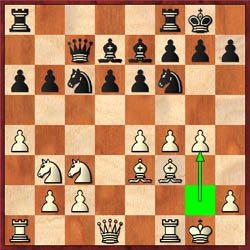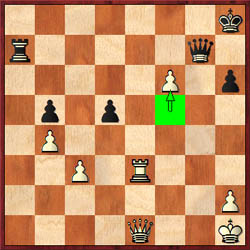 |
 |
 |
 |
 |
 |
|
|
|
|
|
|
|
 |
|
|
|
|

|
|
|
|
|
|
|
|
|
Round #10 Pairings
Topolov (Bulgaria) - Morozevich (Russia)
Adams (England) - Anand (India)
Leko (Hungary) - Svidler (Russia)
Kasimjanov (Uzbekistan) - Polgar (Hungary)
***
Round #10 Results
Adams-Anand, ½-½. This round started with the mere coincidence that on two boards the identical position arose for twelve moves. This had happened to Anand once before in a team event, but this time it would be the anti-Marshall with 8.a4 was featured. We have seen two Marshall Gambits in the tournament and neither was decisive, so this tells us that Anand may have been trying to avoid a draw by taking a different route. Anand executed a different plan than the other anti-Marshall, but the hostilities ended after 25 moves. Only a pair of bishops and a pair of pawns were exchanged. Certainly a disappointment for Anand who is displeased with his play and perhaps has already conceded victory to Topalov. (game)
Kasimjanov - Polgar, 1-0. As billed, this was the game of the round. Both players had reputations to protect coming into the tournament Kasimjanov as defending FIDE World Champion and Polgar as the world's strongest woman in history. Kasimjanov had been playing attacking chess in his previous two rounds, sacrificing pieces and attacking the enemy king. Polgar, on the other hand, has had problems solving her opening problems and may be showing rust from her maternal leave.
|
|
|
|
|
|
|
|
|
|
|
|
|
This game started out as a Najdorf, but switched to a Scheveningen. The only problem was that the setup Polgar used is not optimal against Kasimjanov's setup. After ...b6, the bishop belongs on b7 and the fact that white had played Nb3 made …Bd7 look silly. Usually black will trade knights on d4 and then play …Bc6. After Kasimjanov played the aggressive 13.g4, Polgar's position was already under severe pressure and she had to play the un-Polgar move of 13…Bc8 to make room for …Nd7.
Kasimjanov gained space on the kingside and arranged his pieces for attack. His intentions were already obvious before he played 16.Rf3 and 17.Rh3, so Polgar countered with 20…f5!? This move is a standard thrust when meeting a pawn storm, but Polgar's pieces were not placed properly and later white's attack was unstoppable after 28.Nd4! Black hunkered down and prepared for impact with 28…Rf7. Kasimjanov hit with simple and strong 29.Qh4.
After 29…e5 30.Nxf5, she continued punching in the center with 30…d5!? and her efforts paid off when Kasimjanov allowed her to slip away when he missed the powerful 31.Qh5! followed by g6. He played 31. g6 Qb6+ 32.Kh1 Qxg6 and 33.Rxe5? instead of 33.fxe5 winning on the spot. While Kasimjanov was still winning, the next several moves forced exchanges and a draw appeared imminent. There was deep disappointment from the fans and commentators as Kasimjanov let apparently let another one slip away.
Undeterred, Kasimjanov played 45.f6! This turned out to be the côup de graçe because after 45…Qxf6 46.Re7+ Kh7 47.Qb1+! Polgar would either lose a rook, her queen or get mated. She chose to resign and continued her skid further into last place. In the press conference GM Grigory Kaidanov reported that Kasimjanov stated that he knew he missed something, but figured the position was still winning. (game)
|
|
|
|
|
|
|
|

|
|
|
|
|
|
|
|
|
|
This setup by Polgar lacks the flexibility of a 'hedgehog' and Kasimjanov was able to exploit Polgar's continued struggles in the opening.
|
|
|
|
|
|
|
|
|
|

|
|
|
|
|
|
|
|
|
|
After missing several winning continuations, it appeared that the game would be drawn, but Kasimjanov finished the game nicely with a single stroke of 45.f6!
|
|
|
|
|
|
|
|
|
|
|
|
|
|
|
Leko - Svidler, ½-½. For the first 12 moves, this game mimicked the Adams-Anand contest, but Svidler's approach appeared to yield an inferior position after 17…Bc8. Leko probed the queenside but was unable to make any progress. This game was uneventful and neither player threatened. The result is disappointing for Leko who has unable to put a rally together to challenge for one of the top four places. He is 4th-5th with Morozevich who is rounding into form. Svidler, who has held 2nd position, for several rounds, has Anand on his heels and a match with the red-hot Morozevich in the next round. (game)
Topalov-Morozevich, ½-½. This game was as intriguing as it was shocking. Topalov had actually failed to finish an opponent! This game went at a nice fluid pace, but slowly Topalov continued to improve his position. The key position came after 27.f4! Qc3! Morozevich's resourceful led him to a decent position, but Topalov was determined and forged ahead with 35.e6! This appeared to give Topalov a definite advantage as 35…fxe6?? would be met with the ruthless 36.Rc7! g6 37.Qe5! Morozevich went back on his heels with defensive moves, but was unable to protect f7 and got a totally lost position.
A moment occurred when Morozevich decided to play a few moves before having to resign. All of a sudden he got his chance after the passive 46.Rc2? And after 46…Qf2! He was threatening both 47…Nf3+ and 47…Nf1+. After being forced to sacrifice the exchange to avoid perpetual check, Topalov continued to press and reached a key position after 51.Bc6. Kaidanov and GM John Federowicz were working out the analysis and found some beautiful lines requiring Morozevich to defend precisely.
"Moro" indeed found the move 51…g6! securing the draw. On 52.f6, black plays 52…g5 and runs his king forward. If black can pry open the kingside and loose his rook while holding the f7-pawn back then black would actually win. The key line however,went 52. Be8 Kg7 53.fxg6 h5! Assuring that white kingside pawns were kept at bay. Topalov tried one last trick. After 58.h5, black cannot play 58…Rxh5?? due to 59.f8(Q)+! Kxf8 60.g6+ Kxg6 61.Bxh5. When black simply played 58…Kf8 the game ended peacefully. (game)
|
|
|
|
|
|
|
|
|
|
|
|
|
Standings:
1st Topalov, 8-2
2nd-Svidler, 6-4
3rd-4th Anand, Morozevich, 5½-4½
5th-6th Leko, Kasimjanov, 4½-5½
7th Adams, 3½-6½
8th Polgar, 2½-7½
|
|
|
|
|
|
|
|
|

|
|
|
|
|
|
|
|
|
 |
|



